Top 15 Crypto Staking Platforms in 2023
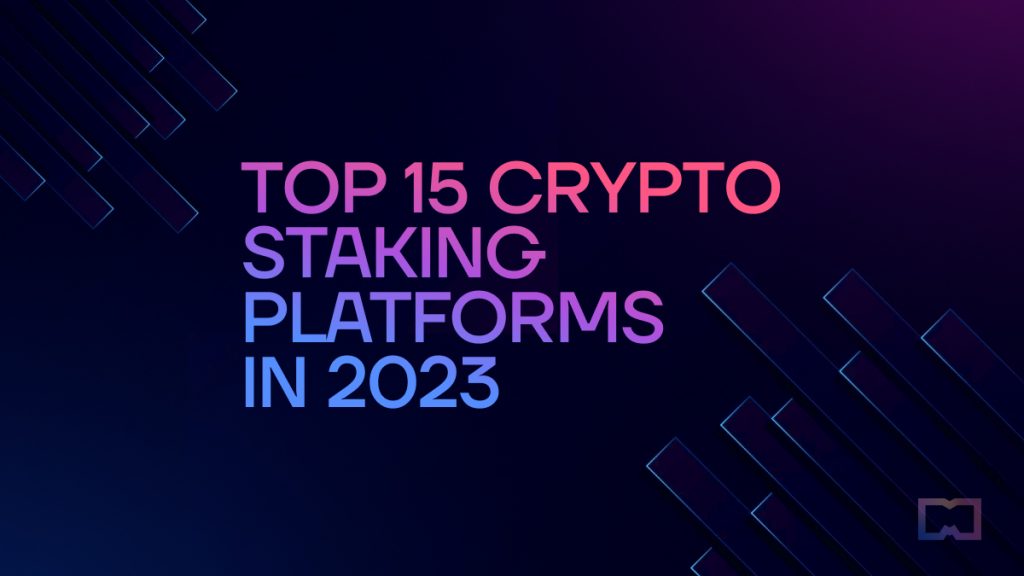
Crypto staking has surged in popularity as a preferred investment strategy, allowing crypto holders to earn rewards while keeping their assets. This process involves maintaining a specific amount of cryptocurrency in a wallet or on a designated platform, contributing to the health of a blockchain network. In exchange, users receive rewards, typically in the form of extra cryptocurrency. You can liken it to earning interest on money in a savings account. As decentralized finance (DeFi) grows and blockchain technology becomes more mainstream, many investors are looking at crypto staking as a lucrative option.
Why do people stake crypto?
Many individuals engage with crypto staking platforms primarily to tap into the potential for generating passive income. Staking rewards can provide a steady income stream for those who prefer to hold onto their cryptocurrency investments rather than actively trading. It's a low-effort way to earn money without needing to juggle trading or exploring other investment avenues. Moreover, by staking, users are supporting the network's integrity and enhancing its security, acting as validators, which can be immensely beneficial for those who are dedicated to the ongoing success of a specific blockchain initiative.
Understanding the distinction between staking and lending is crucial.
Numerous crypto exchanges and wallets offer rewards through lending or on-chain staking. When participating in lending, users deposit their crypto assets into a lending pool where they can be borrowed by others, either under fixed or variable interest rates. The platform keeps a portion of the interest generated, while compensating you with the remainder of the yield.
In contrast to lending, staking involves locking your assets in a smart contract that operates based on the network's proof-of-stake consensus mechanism. Your cryptocurrency plays a vital role in securing the network, validating transactions, and creating new blocks. In return, you receive a share of the newly minted coins. Keep in mind that many staking platforms may impose fees or commissions for their services.
Key Points to Consider When Selecting a Crypto Staking Platform
Regardless of whether you choose to stake or lend, particularly on exchanges, it's critical to remember that your funds aren’t under your complete control. When selecting a crypto staking platform, undertake thorough research into its reputation and the security protocols it employs to safeguard your funds. Additionally, look for platforms that are transparent about their staking processes, including details on fees, rewards, and the withdrawal method. It’s also vital to identify which cryptocurrencies are supported and what rewards can be expected for staking each one.
This article will delve into some of the leading crypto staking platforms available today, outlining their unique features, benefits, and any potential drawbacks or important factors to consider. By providing a broad overview of the top options, we aim to assist investors in making informed choices regarding where to stake their cryptocurrencies and earn rewards. platforms This platform serves as a comprehensive node hosting and staking service, enabling users to stake as many as 71 different cryptocurrencies, such as Bitcoin, Ethereum, and Polygon. It boasts a user-friendly interface that simplifies the management of staked assets and node operations.
Top 15 crypto staking platforms
AllNodes
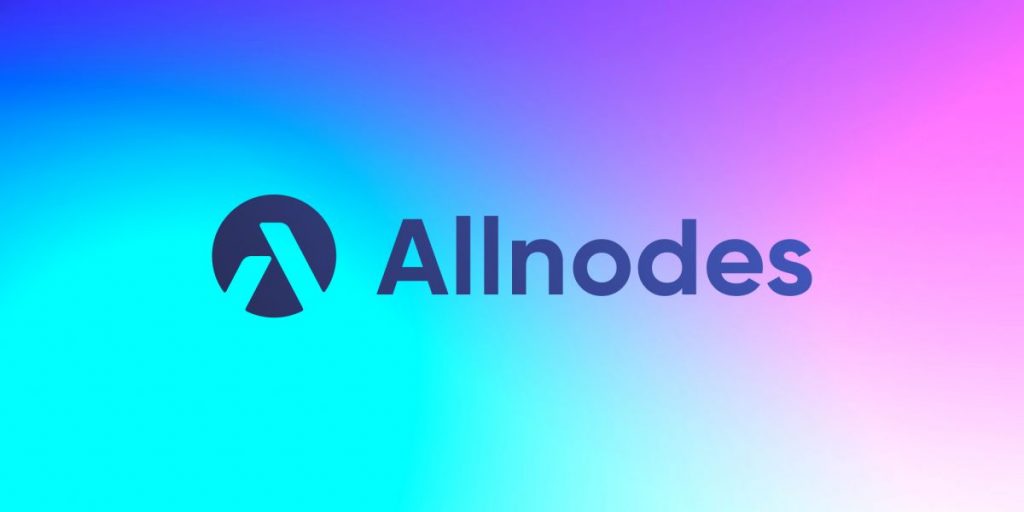
AllNodes The platform holds a valuation exceeding $2 billion, with upwards of 34,000 hosted nodes. It facilitates staking from hardware wallets and presents enticing rewards that generally range between 3% and 35%, depending on the specific token.
Offers a diversified portfolio for staking various cryptocurrency coins.
Pros:
- Features a straightforward and easy-to-navigate interface that welcomes beginners to the staking world.
- Competitive staking rewards
- Absence of a mobile application may pose an inconvenience for users wishing to manage their staked tokens while on the move.
Cons:
- Founded in 2018, this decentralized staking provider leverages enterprise-level technology to maintain over 8,000 nodes across 70-plus blockchain networks, including well-known names like Solana and Cardano. It has developed liquid staking products, such as Eversol. With over 625,000 unique users and $6.2 billion in staked assets, this platform is notable for its scale.
Everstake

Provides support for a broad array of cryptocurrencies. Everstake Competitive staking rewards that vary from 5% to 49%, contingent on the specific token involved.
Pros:
- User-friendly platform with effective management tools.
- Higher fees for staking compared to certain rival platforms.
- No mobile application for staked token management.
Cons:
- This platform enables users to stake their tokens, garner rewards, and bolster the security of diverse blockchain networks. It operates validators for more than 20 protocols, including Ethereum and Polkadot.
- Established as a trusted validator since 2018, this platform has solidified its position in the crypto landscape, supporting over $1 billion in assets from both retail and institutional clients. Stakefish claims that its globally distributed team guarantees round-the-clock monitoring of its validator nodes, providing users with peace of mind.
Stakefish

Stakefish Staking rewards are competitive, ranging between 5% and 62%, depending on the token.
Offers staking options across over 20 blockchain networks.
Pros:
- Limited insights into its security practices.
- This decentralized staking platform allows users to earn rewards on Ethereum holdings. It enables staking of ETH, SOL, and MATIC tokens through a smart contract managed by a pool of validators.
Cons:
- Among its advantages, the platform permits staking of any amount of ETH, features high staking rewards, and imposes no minimum staking term. Additionally, staked ETH tokens remain liquid, making them tradable whenever desired. Over 291,000 stakers have collectively staked more than 10 million tokens on the platform, with rewards exceeding $500,000 doled out.
- No mobile app available
Lido
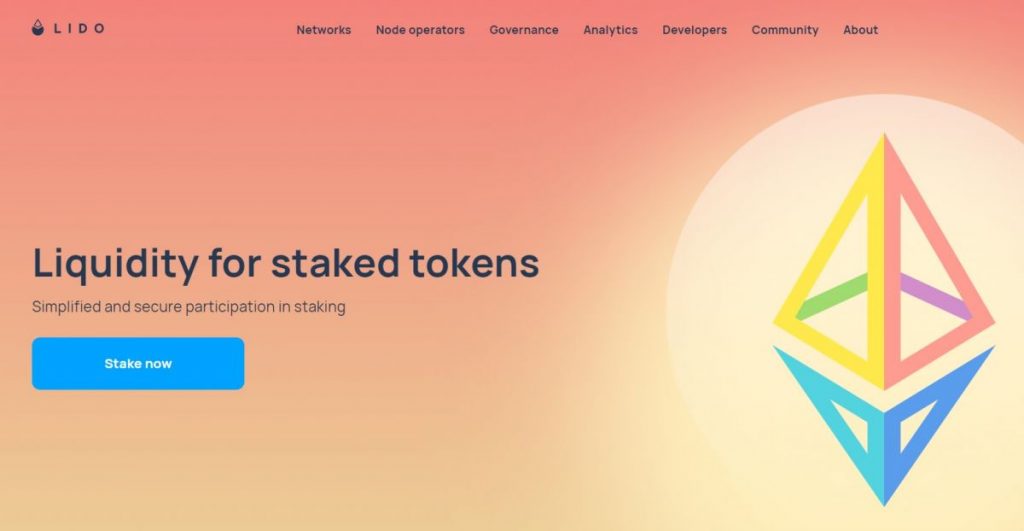
Lido Users can stake any quantity of ETH.
Liquid ETH tokens can be traded on demand.
Pros:
- Restricted to staking only ETH, MATIC, and SOL.
- Staking rewards from 4-6%
- This is an innovative and permissionless DeFi middle layer that connects Capital Aggregators with DeFi Yield Generators, facilitating dynamic and efficient fund allocation while optimizing yields for strategies that are overseen by DAO-curated Risk Models.
Cons:
- The platform provides an infrastructure solution designed for creating and investing through 'Smart Vaults' that manage risk. Users can tailor their individual Smart Vaults to reflect their specific risk preferences. Upon depositing assets, Spool automatically oversees and rebalances investments across various DeFi protocols, relieving users from the burden of incurring gas fees. Users can also earn performance fees when others decide to invest in their Smart Vaults.
SpoolFi
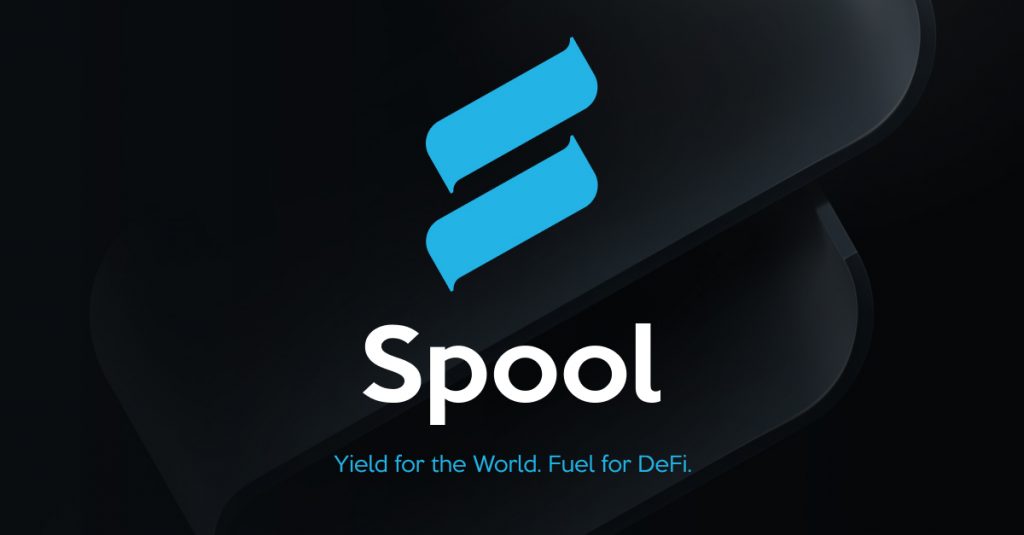
Spool A risk-managed methodology to yield farming.
Users can customize Smart Vaults to suit their unique risk tolerance.
Pros:
- The auto-rebalancing feature across multiple DeFi protocols ensures users avoid gas fees.
- Performance fees charged to Smart Vault creators may deter some users from developing their own vaults.
- This staking platform accommodates over 100 different cryptocurrencies, providing secure and efficient node hosting alongside attractive staking rewards exceeding 14% APY.
Cons:
- The platform presents a user-centric interface with an assortment of tools for monitoring staked tokens and tracking rewards. Additionally, it features a marketplace for buying and selling cryptocurrencies, offers crypto mining services, and provides cashback options from over 2300 global retailers.
MyCointainer
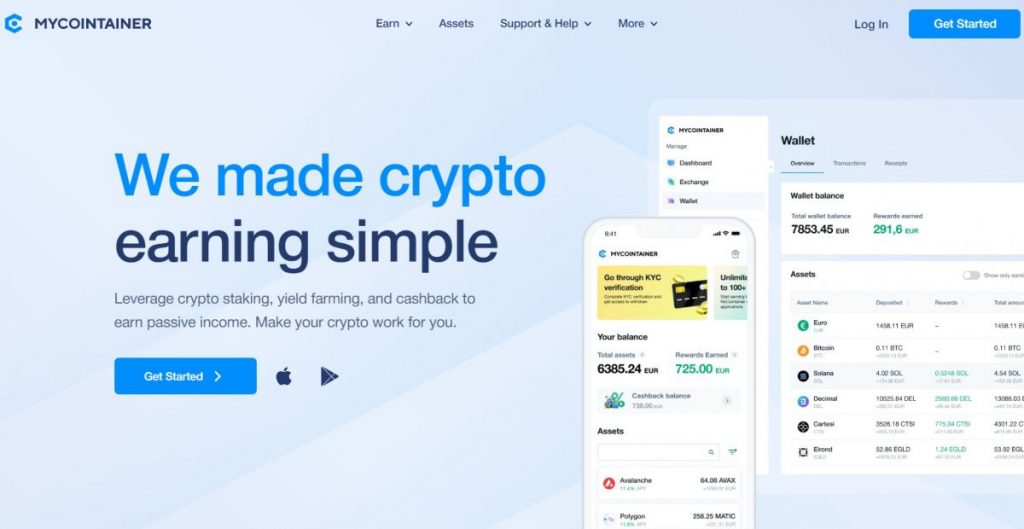
MyCointainer No lockup period applies for over 100 available staking assets.
Claims to deliver daily rewards with minimal fees.
Pros:
- Includes a mobile app for overseeing staking activities.
- Lacks detailed information regarding staking fees or commissions.
- This multichain liquid staking platform offers users the flexibility to access their assets while still deriving staking rewards. Unlike traditional staking setups that lock user funds for set durations, liquid staking utilizes DeFi escrow accounts, allowing users to access their tokens at any moment, hence making their assets liquid. This functionality enables users to leverage their staked tokens as collateral for other financial ventures such as lending and trading, potentially creating multiple revenue streams.
Con:
- The platform is compatible with nine different networks, such as Ethereum, Fantom, and BNB, among others.
Stader

Stader Enhanced liquidity and flexibility. proof-of-stake Users maintain control over their capital while gaining the ability to use it for additional endeavors.
Potential for greater returns as staked tokens can be utilized for various financial transactions that harvest further passive income.
Pros:
- May present complexity and challenge compared to standard staking platforms, since liquid staking involves supplementary financial transactions and collateralization.
- Regulatory uncertainties surrounding liquid staking could expose users and service providers to legal risks.
- Built on the Ethereum network, this decentralized staking provider operates as a non-custodial platform supporting nearly 40 tokens such as ETH and DOT. The platform features staking APY varying from 5% to 43%, with a 5% commission rate to sustain its infrastructure. With over $612,000 locked in assets and more than 38,000 users staking across 34 networks, it has established a significant presence.
Cons:
- The 15 Leading Crypto Staking Platforms to Explore in 2023 - Metaverse Post
- In recent times, crypto staking platforms have seen a surge in popularity as a method for investors to receive rewards while retaining their cryptocurrency holdings.
Stakely
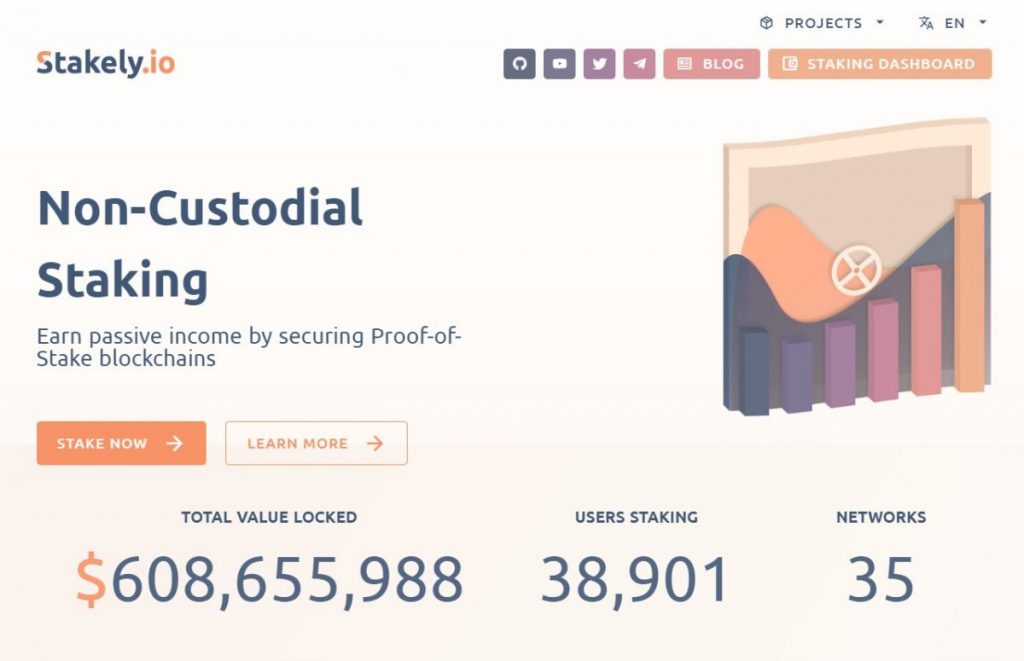
FTC's Attempt to Block the Microsoft-Activision Merger Fails Stakely Date Published: April 05, 2023, at 11:21 AM, Updated: April 05, 2023, at 11:21 AM
To enhance your experience in your preferred language, we sometimes utilize an automatic translation tool. Keep in mind that this automatic translation may not be entirely precise, so please read carefully.
Pros:
- Crypto staking platforms are gaining traction as they allow investors to earn rewards simply by holding their digital assets. Staking requires users to keep a specific quantity of cryptocurrency either in a wallet or on a staking platform to facilitate the functioning of a blockchain network. In return, they receive rewards in the form of additional cryptocurrency. You might think of it as similar to earning interest on savings at a bank. With the growth of decentralized finance (DeFi) and the broader acceptance of blockchain technology, staking has turned into a sought-after investment strategy for many individuals.
- Low commission fees
- Distinguishing Between Staking and Lending
Cons:
- Key Factors to Consider When Selecting a Crypto Staking Platform
Ledger Live
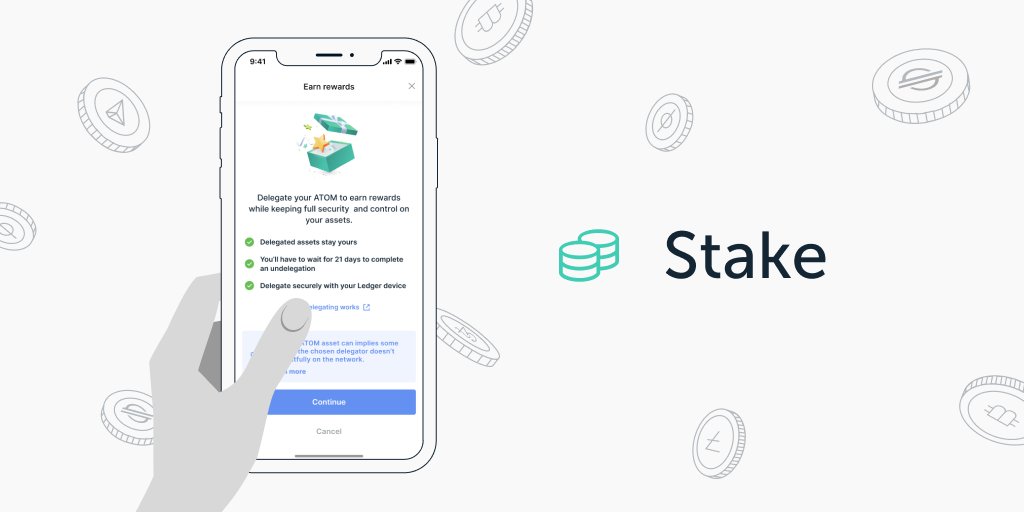
There are numerous reasons individuals opt for crypto staking platforms, the most apparent being the opportunity to earn passive income. The rewards from staking can provide a consistent income stream for long-term cryptocurrency holders who are not inclined to sell their coins shortly. It's a hands-off way to generate earnings since it doesn’t involve actively trading or managing other assets. Furthermore, staking contributes to the security of the network by enabling users to act as validators, which is particularly appealing for those committed to the long-term viability of a specific blockchain project.
Pros:
- Over 400 cryptocurrencies supported
- Various cryptocurrency exchanges and wallets feature incentives through lending or on-chain staking. In lending, you place your cryptocurrency into a platform's lending pool, which others can borrow from at a set or fluctuating interest rate. The platform typically takes a portion of the earnings it generates from lending and compensates you with the remainder.
- In contrast to lending, staking involves locking your assets within a smart contract aligned with the network's proof-of-stake consensus mechanism. Your cryptocurrency plays a vital role in network security, transaction confirmations, and block generation, and a share of the newly minted coins is subsequently distributed to you. It's worth noting that many staking platforms impose fees or commissions for their services.
Cons:
- Regardless of whether you choose staking or lending, particularly through crypto exchanges, it’s crucial to recognize that your funds may not be in self-custody. When selecting a crypto staking platform, undertaking thorough research on its reputation and security practices is vital to safeguard your assets. Moreover, look for platforms that clearly outline their staking process, including information on fees, potential rewards, and the procedure for fund withdrawals. Additionally, assess which cryptocurrencies the platform supports and the possible rewards associated with staking each one.
- This article will delve into some of the best crypto staking platforms currently available, shedding light on their unique features and advantages while also addressing possible downsides or factors to consider. By presenting an overview of the leading options in this space, we aim to assist investors in making informed choices regarding where to stake their cryptocurrencies and earn rewards.
Aave v2 Ethereum

Aave Here’s one platform that acts as a comprehensive solution for node hosting and staking, allowing users to stake as many as 71 different cryptocurrencies, including popular names like Bitcoin and Ethereum, in a manner that’s user-friendly. It provides an approachable interface for managing staked tokens and running a node effectively.
This platform boasts a value exceeding $2 billion and operates over 34,000 hosted nodes. It facilitates staking from hardware wallets and offers attractive rewards ranging from 3% to 35%, depending on the particular token.
Pros:
- Covers a broad selection of cryptocurrencies for staking.
Cons:
- Features a straightforward and user-friendly interface, making it accessible for newcomers to the staking scene.
- Lacks a mobile application, which might be a downside for users who prefer managing their staked assets while on the move.
Ankr
Founded in 2018, this decentralized staking provider utilizes enterprise-grade hardware to support over 8,000 nodes across more than 70 blockchain networks, such as Solana, Cosmos, Tezos, Polygon, and Cardano. The platform is known for creating liquid staking options like Eversol. With over 625,000 unique users, it has $6.2 billion of assets under staking.
Pros:
- Covers a wide variety of cryptocurrencies.
Cons:
- Limited number of supported tokens
- Offers competitive staking rewards ranging from 5% to 49%, depending on the token.
Binance
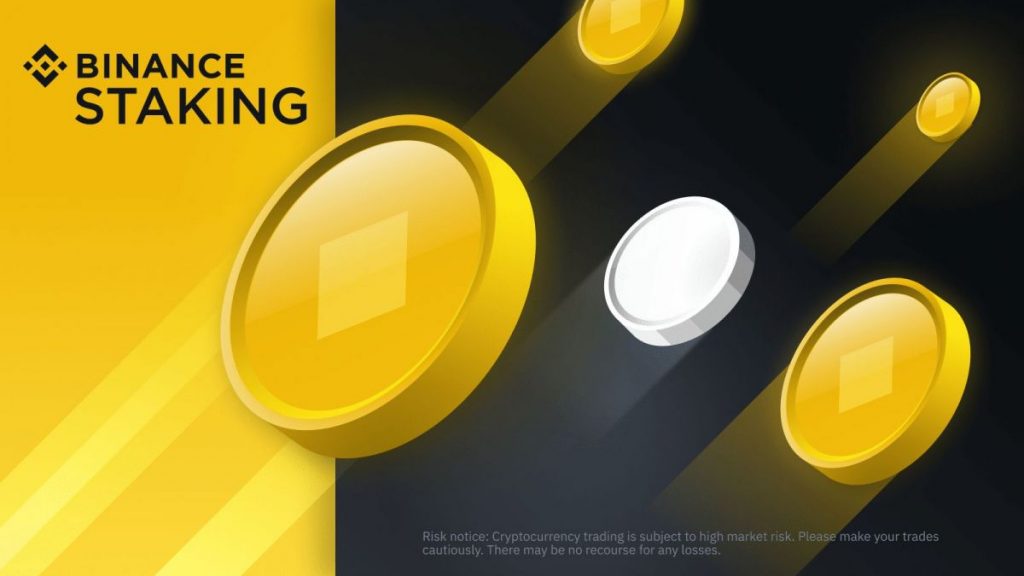
Boasts an intuitive user interface and effective management tools. staking Charges higher staking fees compared to some alternatives.
Currently does not have a mobile app to facilitate staking token management.
Pros:
- This platform allows users to earn staking rewards by securing numerous blockchain networks. It operates validators across over 20 different protocols, including Ethereum, Cosmos, and Polkadot.
- With validator operations dating back to 2018, it has built a reputable standing as one of the most trusted validators in the crypto sphere. The platform manages more than $1 billion in staked assets from both individual and institutional investors. Stakefish emphasizes that its globally distributed team provides round-the-clock oversight of its validator nodes, which brings a sense of security to users.
- Offers competitive staking rewards that range from 5% to 62%, depending on the token.
Cons:
- Provides staking services for over 20 different blockchain networks.
- There’s limited transparency regarding security measures.
- As a decentralized staking platform, it empowers users to earn rewards from staking their Ethereum holdings. Users can stake their ETH, SOL, and MATIC tokens through a smart contract managed by a pool of validators.
OKX

Some key benefits of this platform include the flexibility to stake any amount of ETH, high staking rewards, and no minimum staking duration. Moreover, the staked ETH tokens are liquid, enabling users to trade them anytime. Over 291,000 stakers have collectively staked more than 10 million tokens on this platform, resulting in rewards exceeding $500,000. Staking on OKX Allows staking of any amount of ETH.
Pros:
- Liquid staked ETH tokens can be traded without constraints.
- Participation is limited to staking ETH, MATIC, and SOL.
- High APY for fixed-term staking
- No commission fee
Cons:
- This platform operates as an efficient and permissionless DeFi middleware that links Capital Aggregators with DeFi Yield Generators, ensuring dynamic and automated fund allocation for optimized yields through DAO-curated Risk Models.
- Offering an infrastructure solution, it helps users create and invest through 'Smart Vaults' designed to manage risk. Users can build custom Smart Vaults tailored to their individual risk preferences. Once users deposit assets into a Smart Vault, Spool automatically oversees and adjusts investments across various DeFi protocols without users needing to concern themselves with gas fees. Additionally, users can earn a performance fee when others invest in their Smart Vault.
Coinbase
Coinbase Adopts a risk-managed approach to yield farming.
Pros:
- Users are empowered to forge customized Smart Vaults reflecting their personal risk tolerance.
- The auto-rebalancing feature across diverse DeFi protocols spares users from incurring gas fees.
Cons:
- The performance fee imposed on Smart Vault Creators might deter some individuals from creating their own custom Smart Vaults.
- This staking platform caters to over 100 cryptocurrencies and provides secure, reliable node hosting as well as attractive staking rewards averaging over 14% APY.
Kraken
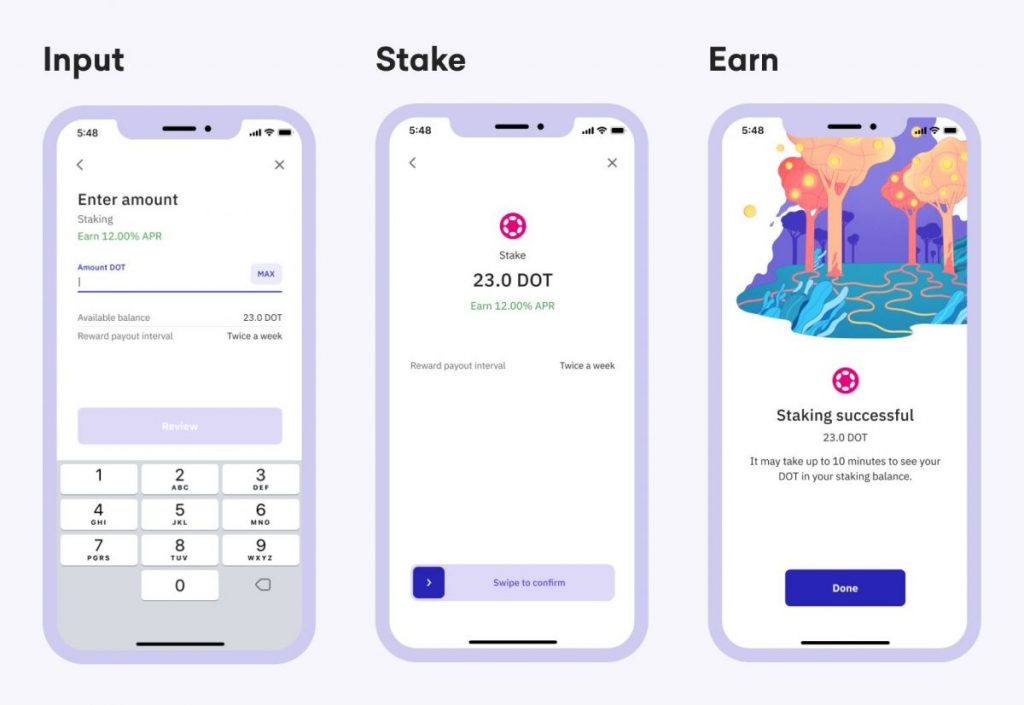
Despite having to shut down staking for US users, Kraken It features an easy-to-navigate interface and various tools for overseeing staked tokens and tracking rewards. Additionally, the platform offers other services, including a marketplace for trading cryptocurrencies, mining options, and cashback from shopping at over 2300 global retailers.
Pros:
- Instantly unstake with no penalties
- No fees for staking or unstaking
Cons:
- No lock-up periods for over 100 supported staking assets.
Crypto staking platform cheat sheet
| Crypto staking platform | APY % | No. of cryptocurrencies supported | Pros & cons |
| AllNodes | 3 -35% | 71 | Pros: Promises daily rewards and modest fees. – Competitive staking rewards – Simple and intuitive interface Cons: – No mobile app |
| Everstake | 5 – 49% | 6 | Pros: – Competitive staking rewards Includes a mobile application allowing users to manage their staking activities. Cons: – Relatively high staking fees – No mobile app |
| Stakefish | 5 – 62% | 22 | Pros: – Competitive staking rewards Provides no concrete details on staking fees or commission. Cons: Operates as a multichain liquid staking platform that grants users access to their assets while still receiving staking rewards. Unlike traditional staking platforms, where user funds are restrained for specific durations, liquid staking secures funds within DeFi escrow accounts, ensuring users can access their tokens at any time. This model allows users to utilize their staked tokens for other financial activities, such as lending, borrowing, or trading, creating various income opportunities. – No mobile app |
| Lido | 4 – 6% | 5 | Pros: The platform supports nine different networks, including Ethereum, Fantom, BNB, Polygon, Near, among others. Enhances liquidity and flexibility. Cons: Maintains control over your assets while enabling their use for alternative purposes. Offers the potential for higher returns since staked tokens can also be employed in additional financial transactions that result in passive income. |
| SpoolFi | 2 – 25% | USDC, USDT, DAI | Pros: Might require a more intricate understanding and operation than standard staking platforms due to the additional financial dealings and collateralization associated with liquid staking. – Custom Smart Vaults available The regulatory uncertainty surrounding liquid staking could expose users and service providers to legal and regulatory challenges. Cons: As a decentralized staking provider established on the Ethereum network, this platform is non-custodial and supports nearly 40 tokens, including ETH, FTM, DOT, and more. It offers staking APYs ranging from 5% to 43%, determined by the specific token. The platform charges a 5% commission to manage its infrastructure costs, holding a total value of over $612,000 with more than 38,000 users participating in staking across 34 networks. |
| MyCointainer | 4 – 153% | 100 | Pros: – No lockup period The 15 Best Platforms for Crypto Staking in 2023 - Metaverse Post – Mobile app Cons: In recent years, crypto staking platforms have gained significant traction among investors looking to earn rewards while holding onto their cryptocurrencies. |
| Stader | 5 – 100% | 7 | Pros: FTC's Attempt to Prevent the Microsoft-Activision Merger Falls Short – Retain control over your assets Date of Publication: April 5, 2023, at 11:21 AM, last updated on the same day at 11:21 AM. Cons: To enhance your experience in your local language, we sometimes utilize an automatic translation tool. Please be aware that this automated translation may not always be accurate, so read carefully. Crypto staking platforms have surged in popularity due to their ability to allow investors to earn passive income while retaining their cryptocurrency holdings. The process of staking requires you to lock away a specific quantity of the cryptocurrency in a designated wallet or on a platform, helping to maintain the operations of a blockchain network. In return, you receive rewards in the form of additional cryptocurrency—similar to earning interest on money saved in a bank. With the growing influence of decentralized finance (DeFi) and the wider acceptance of blockchain technology, staking has emerged as an appealing investment strategy for a broad audience. |
| Stakely | 5 – 43% | 40 | Pros: – Staking insurance – Low commission fees – Non-custodial platform Cons: Understanding the Differences Between Staking and Lending Key Factors to Consider When Selecting a Crypto Staking Platform |
| Ledger Live | n/a | > 400 | Pros: – Over 400 cryptocurrencies supported – Hardware wallet integration People turn to crypto staking platforms for various reasons, the most prominent being the opportunity to earn a passive income. For long-term crypto holders who aren't planning to liquidate their assets anytime soon, staking rewards can provide a reliable income source. It's an effortless way to generate income as it doesn't involve the need for active trading or investing in different assets. Moreover, by engaging in staking, users can contribute to the security and reliability of the network by acting as validators, which can be especially beneficial for those who support the long-term viability of a specific blockchain project. Cons: Various cryptocurrency exchanges and certain wallets offer opportunities to earn rewards through lending or on-chain staking methods. In lending, you place your crypto into a lending pool on a platform, which is subsequently borrowed by others at either a fixed or variable interest rate. The platform takes a cut for facilitating this lending while the rest of the yield is paid to you. Conversely, with staking, your assets are locked in a smart contract governed by the network’s proof-of-stake mechanism. Your cryptocurrency goes toward securing the network, validating transactions, and producing new blocks, with a portion of the freshly minted coins being paid out to you. Keep in mind that many staking platforms charge fees or commissions for their services. |
| Aave v2 Ethereum | Up to 14% | Whether you're engaging in staking or lending—particularly on crypto exchanges—it's crucial to recognize that your assets aren't held in self-custody. Before committing to a crypto staking platform, take the time to investigate its reputation and security measures to safeguard your investments. Furthermore, look for a platform that provides a transparent staking process, detailing information about fees, potential rewards, and withdrawal procedures. It's also necessary to evaluate the cryptocurrencies supported by the platform and the respective rewards tied to staking each one. | Pro: In this article, we aim to delve into some of the premier crypto staking options available today, shedding light on their unique features and benefits, as well as any potential downsides or factors to consider. Our goal is to give investors a well-rounded view of the best places to stake their cryptocurrencies and earn rewards in the process. Con: – Low staking rewards – Supports staking for two tokens |
| Ankr | 3 – 16% | 80 | Pros: is a comprehensive node hosting and staking platform that lets users effortlessly stake 71 different cryptocurrencies, encompassing popular tokens like Bitcoin, Ethereum, and Polygon. The platform offers a user-friendly interface, allowing individuals to easily manage their staked tokens and operate a node on the network. The platform boasts a valuation exceeding $2 billion, supported by over 34,000 hosted nodes. It facilitates staking from hardware wallets and provides enticing staking rewards that range from 3% to 35%, depending on the specific token. – High APY for fixed-term staking – No commission fee Cons: Offers a diverse array of coins available for staking – Slow customer support response time |
| Binance | Up to 104% | 60+ | Pros: Features an intuitive interface that simplifies the staking process for beginners – High staking rewards – Mobile app available Cons: – A centralized platform Lacks a mobile application, which might be an inconvenience for users who prefer to manage their staked tokens on the go |
| OKX | 0.1% – 56.8% | 78 | Pros: A decentralized staking service established in 2018, The platform boasts a valuation exceeding $2 billion, supported by over 34,000 hosted nodes. It facilitates staking from hardware wallets and provides enticing staking rewards that range from 3% to 35%, depending on the specific token. – High APY for fixed-term staking. – No commission fee Cons: employs top-tier hardware to run upwards of 8,000 nodes across more than 70 blockchain networks, such as Solana, Cosmos, Tezos, Polygon, and Cardano. The platform specializes in creating liquid staking products like Eversol. Everstake currently serves over 625,000 unique users with a staggering $6.2 billion worth of assets staked. – Slow customer support response time |
| Coinbase | Up to 6% | 103 | Pros: – User-friendly interface Supports a broad selection of cryptocurrencies Cons: – High staking fee Offers attractive staking rewards that range from 5% to 49%, based on the token type |
| Kraken | 1 – 24% | 18 | Pros: Provides a user-friendly interface along with solid management tools – No fees for staking or unstaking Cons: Charges higher staking fees compared to some other providers Does not have a mobile app for managing staked tokens |
FAQ
enables users to stake their assets and receive rewards while contributing to the security of multiple blockchain networks. The platform manages validators across more than 20 different protocols, including Ethereum, Cosmos, and Polkadot, among others.
Having operated validators since 2018, the platform has established itself as one of the most reputable and reliable validators in the crypto sphere. It facilitates over $1 billion in staked assets from both institutional and retail investors, ensuring peace of mind with a globally distributed team that provides round-the-clock monitoring of its validator nodes.
Staking rewards are competitive, ranging from 5% to 62%, depending on the token
Offers staking services across more than 20 distinct blockchain networks
Limited transparency regarding its security protocols
is a decentralized staking service focused on providing users with rewards for their Ethereum holdings. The platform allows staking of ETH, SOL, and MATIC tokens through a smart contract managed by a pool of validators.
Conclusion
The platform brings several advantages, including the ability to stake any amount of ETH, lucrative rewards, and the absence of a minimum staking period. Furthermore, Lido’s staked ETH tokens maintain liquidity, allowing users to trade them at their convenience. To date, more than 291,000 stakers have locked in over 10 million tokens through the platform, resulting in more than $500,000 in rewards distributed.
Permits users to stake any size of ETH investment option Liquid staked ETH tokens can be easily traded at any moment
Read more:
- Top 30+ Crypto Gambling Websites in 2023
- Restricts staking solely to ETH, MATIC, and SOL
- 10+ Best AI Crypto Projects of 2023
Disclaimer
In line with the Trust Project guidelines is a composable and permissionless DeFi middleware that links Capital Aggregators with DeFi Yield Generators to allocate resources dynamically, efficiently, and automatically, optimizing yields for custom strategies managed by DAO-curated Risk Models.







